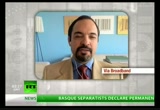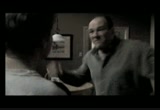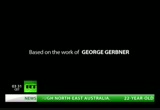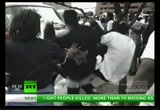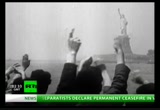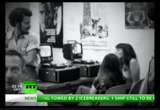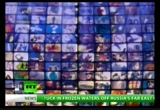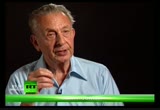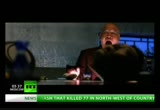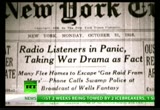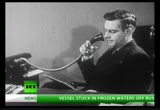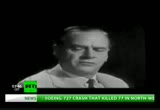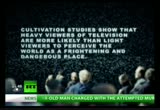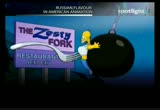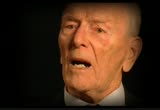tv [untitled] January 10, 2011 9:30pm-10:00pm EST
9:30 pm
they're of their income on basic necessities i mean i'm talking about housing food and clothing. you know if you're spending seventy percent of your income on housing food and clothing and there's a serious rise in group prices you know it's going to hit you and it's going to hurt you a lot you know and i wrote a paper about this that i think i estimated that huey two and the effects of two in terms of commodity inflation as it were reached agriculture products would affect roughly eighty percent of the u.s. population so you don't have to go looking for poor people in india to see how this beggar thy neighbor policy is going to affect people you just have to go to the middle classes and lower middle classes of the united states to see how it's going to hurt our agone bel-air thanks so much for being on the kaiser report it's a pleasure being on thank you for having me all right that's going to do it for this edition of the kaiser report with may max kaiser and stacey everett our thank my gaskins i will they're out if you want to send me an e-mail please do so at kaiser reporting r t t v are you until next time this is backscatter saying.
9:31 pm
children down eight thousand by the end of elementary school five hundred sounds of violence spike the age of eighteen. shows to video game show. twenty four hour news channels is now. formulate a steeple just. shakes. those while those who say this is think about it while it is a good try to artistic journalistic features but most of the violence you see is what i call have been god came down from heaven and stopped. at the amen to show. makes the pill easier to.
9:32 pm
9:33 pm
waters the final ship with over three hundred crew on board waits for assistance the rescue operation has been hampered by. the u.s. defense budget can go ahead so long as companies continue to. intend to spend a record seven hundred twenty five billion dollars on its military this year despite more than. the golden age of. the british country as they struggle to get by rising costs and rock bottom interest rates official figures show bankruptcy is growing at the fastest rate of. the number of over sixty five. fold past decade. on screen of violence gets more and more explicit we look at how movies and video games are pushing boundaries
9:34 pm
but also straining people psychology to limit the program contains some graphic images. ever since hollywood acted sad to leave the city wait my two twenties debate has raged about the impact of violent media on our minds and our behavior from alarm about violence in movies in the one nine hundred thirty s. to concerns about the acceleration of violent content across virtually the entire media landscape today hundreds of studies and countless congressional hearings have
9:35 pm
looked at the issue of media violence and always seemed to end up at the same place as anyone disagree with that conclusion that violence in films propagates violent conduct on behalf of the children. a debate about whether those exposed to media violence are prone to imitate and whether media is to blame for society's skills but for all the endless debate a basic question remains. is the issue really about whether we imitate what we see and if that's the case why do the vast majority of us watch t.v. and never commit a violent act. this film looks at the work of a man who took a more complicated look at the issue of media violence as a citizen or. a matter of very green. in wages for many people already. going to
9:36 pm
to going . george herbert exposure to violence came early and on an epic scale first when as a young man he fled to the united states from his native hungary to escape fascism . then a short time later when he enlisted in the us army to fight in world war two. going on to earn the bronze star for bravery as a member of the office of strategic services for parachuting into enemy territory under heavy fire in one of the war's bloodiest battles. with his war experience behind him group who would spend the rest of his wife
9:37 pm
trying to understand violence specifically how the portrayal of violence through images and stories affected our consciousness and behavior in the real world he rose to prominence as one of the world's foremost media scholars serving as dean of the annenberg school for communication at the university of pennsylvania for twenty five years and directing one of the most important and influential research efforts ever undertaken to understand the effects of television he called it the cultural indicators research project since it began in the late one nine hundred sixty s. the cultural indicators project has systematically tracked media violence and measured its impact on the perceptions and attitudes of the viewers. and what gardiner and his colleagues found was that exposure to media violence seemed to have more complicated effects than simply causing people to act violently effects rooted not only in the quantity of violence in the media but also in its quality in
9:38 pm
how it was portrayed in the stories these simulations of violence tell about our relationships to the world and others. today a handful of global conglomerates or no control there telling all the stories in the world. they have global marketing formulas that are imposed on the creative people in hollywood and i am in touch with them and they hated it i say don't talk to me about censorship from washington i never heard about that i get censorship every day i'm told put in more action cut out complicated solutions the apply this formula because it travels well in the global market. these are formulas that need no translation and essentially image driven and speak action in any language and of course the leading element of that formula is violent.
9:39 pm
this is a historically unprecedented tidal wave of images. in every home often with expertly choreographed brutality such as the world has never seen. through them a bench in the best production and the introduction to every home. a relentless for a vase of. exposure to violence and brutality many times a day children dow see about eight thousand murders by the end of elementary school
9:40 pm
and five hundred thousand violent acts by the age of eighteen. from movies to television shows to video games to children's programmes to twenty four hour news channels aggression is now. every day formulaic a staple industrial ingredient. and in fact for gerber it is the nature of this violence that makes it so dangerous and so different from the past this is not the same as traditional story because there was a lot of from shakespeare. there was while unseen fairytales. and that in effect if you think about it while it is a legitimate artistic and journalistic future it is even necessary to shoulder tragedy and pay him one hundred damage that these obsessions with violence
9:41 pm
allusions to human conflict can create in the lives and in communities and in society but most of the violence that we see is what i call happy by. the worry is. this guy's going to be watching his own god spill it has to be highly entertaining violence itself means that they're really good with that they're often glamorous to live but that healer and they always leave through a happy ending. everybody wants come. true reported with humor to be sure i mean to think that god came down from heaven and stopped. them
9:42 pm
was there amen a shot mormon in a free. what uber makes to pill easier to swallow. humor is an excellent communication device because the pillow is the pillow for how or who can get away with what against whom. so from goodness perspective what matters most about media violence is not simply the violent acts on the road but the meaning of all this violence and it's here on this point that governor breaks with an entire tradition. as the documents signed by six of the major public health organizations say that the violence in entertainment to a level that we've been tamed today is causing increased aggressive behavior among some children they. affect on television and indeed most of the media questions and discussion about effective television can be exemplified by the notion that people
9:43 pm
ask about violence they say does it create more violence there is something else that the experts we talked to say about this increase in teen violence and crime they say it may be caused by the messages that are being sent to the teens the effect is supposed to be an imitation and a kind of a monkey see monkey do effect in indianapolis monday off four year old told police he shot his sister in the head because he saw someone do it on the t.v. when you see it was she going to conduct violence are you going to commit violence does anyone disagree with their conclusion that your violence in films. violent conduct on behalf of the children but this is really trivial the contribution of television violence into the actual committing of violence is practically negligible and nobody has been able to demonstrate that it is a significant contributor compared to over to compare to subcultures in which while it's a very frequent compared to many other factors that really the root cause of the
9:44 pm
well. the oversimplified view that media violence causes violent behavior has some troops in the earliest media research which grew out of fears about the sensational and violent content of hollywood's first talking motion pictures and what this violence was doing to the minds of kids who are now flocking to movie houses the best known of these research efforts the pain fun studies of nine hundred twenty nine and i think that you two seem to find that crime and violence in films had a powerful direct and lasting effect on children sowing the seeds for future nervous disorders. and even though this research raised interesting questions in the infancy of media research it missed the bigger picture by focusing on the immediate and short term emotional reactions of audiences exposed to particular
9:45 pm
instances of violence. and perhaps the most influential example of this view that mass media messages have a direct and immediate effect on audiences would come just a few years later i'm still broadcasting the film and it's really a good statement with that orson welles that there are many. more of the world by the west that. we know not all that in the early years but it bends through. it's being watched closely by intelligent. great of a man on october thirtieth one thousand nine hundred thirty eight. orson welles presented the h.g. well science fiction classic more of the world's to a national audience and proceeded to scare the wits out of a good many of his listeners with this victorian tale of alien invasion. thing out
9:46 pm
of that black hole through a minute. they i my dear face like they are a herd of everything. bad that. it was compelling fiction but it sounded like an actual news report and there were reports of widespread panic that aliens had actually invaded the planet. the controversy reinforced fears that had been building for years about the power of mass media to exercise a direct and immediate effect audiences and audience behaviors. the media. many. stories. had such
9:47 pm
a media that. it didn't matter that this apparently immediate and profound effect to be nowhere near as originally reported or that the sensationalized press reports deflected attention away from the fact that the vast majority of people who heard the wells broadcast knew it was fiction and didn't panic at all. the idea that media content seemed capable of exerting some kind of direct and immediate mass mind control over a passive public had taken hold in the popular imagination. in this view which media researchers call the magic bullet theory the assumption is that media messages act. like shots from a gun. leaving our minds changed in their wake. a view of media violence as all powerful and viewers as essentially passive that
9:48 pm
continues to shape debates about media violence to this day. but these cause and effect arguments were simply wrong when it came to making sense of media influence. more science fiction than science they were old approaches based on the outdated notion that people are passive and mass media works on them like some great mind control device like a stimulus applied to lab animals controlling what we think from the outside this way of doing things may have made things easier for social scientists to measure effect by examining and comparing our minds before and after we are exposed to media messages in campaigns. but in view the very idea of a before and after didn't make much sense in the media context for the simple reason as they used to say that with media there is no before we are born into
9:49 pm
a mediated environment the question is how to measure the effects of a force that is present. a sea of images as media scholar to say that has become so familiar to us that we're often as blind to its all encompassing presence as a fish is to water. like a fish in the water we don't water. it is almost beyond perception we have become so accustomed. this leads us to the notion of cultivation cultivation is a stable system of messages and images that shape our conception of the world and of ourselves and of life itself and society and our. question is how do you measure cultivation this is
9:50 pm
a research problem that we faced and we resolved it in the following way we give service to large groups of. representative respondents these surveys have a series of questions not about television not about media but these are questions about life question about security question about values care question about attitudes for example we asked them what are your chances of encountering violence on an average weeknight is it one in a hundred or one in fifty asked would you be reluctant to go down the street in your own neighborhood at night yes or no. separates the responses into heavy and light ears. find that in almost every instance the heavier is exhibit a greater sense of insecurity. and be attributed to the great differing quincey of violence and cantered on television their response patterns of heavy viewers to converge into what we call
9:51 pm
9:52 pm
to create a. view. media in particular presenting a. terrifying. police believe this is the very moment she was abducted she told of the four days she was chained raped and tortured in a virginia townhouse and the woman has been charged with murdering her brother in law after she spiked his fruit punch and of freaks six people accused of organizing fights in a school for the mentally disabled sick used of shooting a man in the head at a four year old's birthday party over the weekend and this sensationalism is especially true with local news which is the primary news source for two thirds of americans with sixty one percent of all lead stories on the local news dedicated to crime fires disasters and. i have to do what i can to protect myself. and that's a fact of life. cultivation. is to show how these kinds
9:53 pm
of anxiety s. and insecurities explicitly with media culture uncovering a direct correlation between the amount of television watches and the level of fear of being victimized. you see that's the image of victimization and image of risk image of. the conception that if there is so much in the world. going to good on the street to be a mugger on the country. street at night. i'm afraid to go into the subways i'm afraid of strangers across the street when i see somebody that i think maybe dangerous to me these are the the consequences of exposure to. it in large communities where we're. finding that if you watch
9:54 pm
a lot of t.v. you're likely to be more afraid of violence than those who watch less t.v. may help explain why so many people seem to think violent crime is far worse than it actually is a widespread misperception that started to be noticed a decade ago when crime rates began to drop here is the reality crime per capita actually dropped slightly in the latest figures released by the justice department nationwide murder was down five percent but the perception continues to dominate reality triggering a fear that is out of sync with the to sticks appear that no one and no place is safe anymore and when you're always on guard it's hard to let go of fear no matter what the reality and this classic example of the mean world syndrome continues today in fact since that a.b.c. news report about falling crime rates justice department figures show that violent crime has dropped in additional forty three percent to a remarkable thirty year low. crime dropped two point five percent to.
9:55 pm
four point four percent. but despite the steady drop polls have consistently shown that most americans believe just the opposite to be true three quarters of americans say there is more crime in the united states than the dog. will crime poll shows it's the highest level since the early one nine hundred ninety s. the poll also finds fifty one percent of americans say there is more crime in their local area than there was a year ago when we see reports like this is it any wonder that american seem more intent than ever on protecting themselves speaking it hitting home check this out i'm a firearms instructor in nassau county florida last weekend we had eighteen people go through our courses to get concealed weapons carry licenses the number of people getting these licenses is astounding everyone expresses a fear of being attacked when i go to jacksonville's concert hall downtown i go
9:56 pm
heavily armed because one of the neighborhoods west of there is the fourth deadliest in america imagine listening to mozart carrying a three fifty seven magnum tough tough stuff indeed scary stuff for a check thank you. we'll. bring you the latest in science and technology from the realm. of the future are covered.
9:57 pm
if. soon which brightened. a bounce from phones to impressions. who threw stones on t.v. don't come. download the official auntie application to go on the phone all i pod touch from the i choose our store. lunch all teach life on the go. video on demand ati's minefield costs and says feeds now in the palm of your. questions on the dot com.
9:58 pm
they faced it this is not a prohibition but a warning of. a form which it let me show you first step is are you sure to support your three strikes they have no idea about the hardships to face. one it's businesses are open to new systems for any army the life of the usaf is the most precious thing in the world. is of self-sacrifice and heroism with those who understand it fully but you have to live a. real life stories from world war two pieces. of the truth one nine hundred forty five dollars on t.v. dot com.
33 Views
Uploaded by TV Archive on

 Live Music Archive
Live Music Archive Librivox Free Audio
Librivox Free Audio Metropolitan Museum
Metropolitan Museum Cleveland Museum of Art
Cleveland Museum of Art Internet Arcade
Internet Arcade Console Living Room
Console Living Room Books to Borrow
Books to Borrow Open Library
Open Library TV News
TV News Understanding 9/11
Understanding 9/11